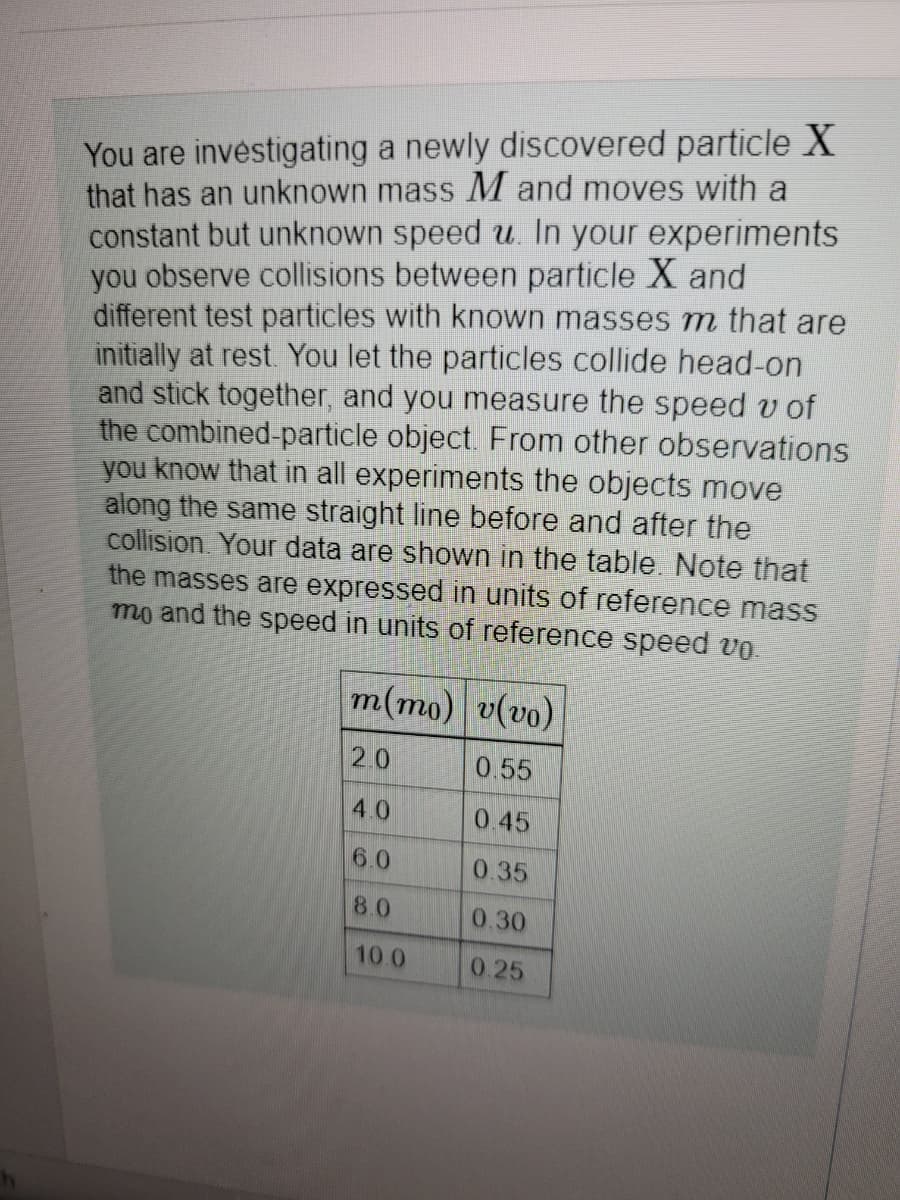You are investigating a newly discovered particle X that has an unknown mass M and moves with a constant but unknown speed u. In your experiments you observe collisions between particle X and different test particles with known masses m that are initially at rest. You let the particles collide head-on and stick together, and you measure the speed v of the combined-particle object. From other observations you know that in all experiments the objects move along the same straight line before and after the collision. Your data are shown in the table. Note that the masses are expressed in units of reference mass mo and the speed in units of reference speed vo.
You are investigating a newly discovered particle X that has an unknown mass M and moves with a constant but unknown speed u. In your experiments you observe collisions between particle X and different test particles with known masses m that are initially at rest. You let the particles collide head-on and stick together, and you measure the speed v of the combined-particle object. From other observations you know that in all experiments the objects move along the same straight line before and after the collision. Your data are shown in the table. Note that the masses are expressed in units of reference mass mo and the speed in units of reference speed vo.
University Physics Volume 3
17th Edition
ISBN:9781938168185
Author:William Moebs, Jeff Sanny
Publisher:William Moebs, Jeff Sanny
Chapter5: Relativity
Section: Chapter Questions
Problem 43P: In a frame at rest with respect to the billiard table, a billiard ball of mass m moving with speed v...
Related questions
Question
Derive an expression for v. Express your answer in terms of M,m, and u.

Transcribed Image Text:You are investigating a newly discovered particle X
that has an unknown mass M and moves with a
constant but unknown speed u. In your experiments
you observe collisions between particle X and
different test particles with known masses m that are
initially at rest. You let the particles collide head-on
and stick together, and you measure the speed v of
the combined-particle object. From other observations
you know that in all experiments the objects move
along the same straight line before and after the
collision. Your data are shown in the table. Note that
the masses are expressed in units of reference mass
mo and the speed in units of reference speed vo
m(mo) v(vo)
2.0
0.55
4.0
0.45
6 0
0.35
80
0.30
10.0
0.25
Expert Solution
This question has been solved!
Explore an expertly crafted, step-by-step solution for a thorough understanding of key concepts.
This is a popular solution!
Trending now
This is a popular solution!
Step by step
Solved in 2 steps with 2 images

Knowledge Booster
Learn more about
Need a deep-dive on the concept behind this application? Look no further. Learn more about this topic, physics and related others by exploring similar questions and additional content below.Recommended textbooks for you

University Physics Volume 3
Physics
ISBN:
9781938168185
Author:
William Moebs, Jeff Sanny
Publisher:
OpenStax

Classical Dynamics of Particles and Systems
Physics
ISBN:
9780534408961
Author:
Stephen T. Thornton, Jerry B. Marion
Publisher:
Cengage Learning

Physics for Scientists and Engineers: Foundations…
Physics
ISBN:
9781133939146
Author:
Katz, Debora M.
Publisher:
Cengage Learning

University Physics Volume 3
Physics
ISBN:
9781938168185
Author:
William Moebs, Jeff Sanny
Publisher:
OpenStax

Classical Dynamics of Particles and Systems
Physics
ISBN:
9780534408961
Author:
Stephen T. Thornton, Jerry B. Marion
Publisher:
Cengage Learning

Physics for Scientists and Engineers: Foundations…
Physics
ISBN:
9781133939146
Author:
Katz, Debora M.
Publisher:
Cengage Learning

Modern Physics
Physics
ISBN:
9781111794378
Author:
Raymond A. Serway, Clement J. Moses, Curt A. Moyer
Publisher:
Cengage Learning

Principles of Physics: A Calculus-Based Text
Physics
ISBN:
9781133104261
Author:
Raymond A. Serway, John W. Jewett
Publisher:
Cengage Learning

College Physics
Physics
ISBN:
9781938168000
Author:
Paul Peter Urone, Roger Hinrichs
Publisher:
OpenStax College